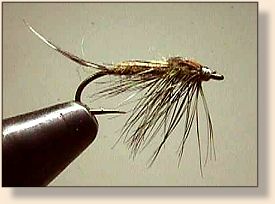|
Trinity Olive
"While fishing a stretch of rough water on Northern California's Trinity River,
I kept switching back and forth between a little olive mayfly nymph and a dark
yellow/gold stonefly. They were both working well, and their similarities gave me
an idea. Instead of changing them all the time, I developed a fly based on standard
mayfly and stonefly shapes with a light olive color. It didn't come out like I wanted
it to, but I started fishing it anyway, and found that I had come up with quite a killing
little pattern that worked even in a slow run as well as stillwaters! I passed some
extras out to associates to see what they thought, and they agreed that it was a
fine searcher nymph. (Oh well, they say Gore-Tex was an accident, too.) I 've had
reports that this fly works well from MI to NC to WA and all over. It is also my number
one fly for Bluegill, and my favorite big water mayfly searcher.
Materials
Hook: TMC 200R or equivalent, sizes 10-16.
Thread: Olive.
Bead: Copper or Gold (optional).
Tail: Grouse Tail Biots.
Body: Light Olive Dubbing.
Rib: Copper Wire.
Wingcase: Grouse Tail Fibers.
Thorax: Light Olive Scintilla Dubbing.
Hackle: Grizzly, palmer-style.
Tying Steps:

1. Tie in tail of Grouse tail biots. Use any biots you
like actually, but I like the dark, mottled fibers from the Ruffed Grouse

2. Tie in gold or copper wire and olive dubbing. Dub tightly 2/3
of the way up the shank, and rib the body.

3. Tie in a wingcase of Grouse quill fibres and grizzly-dyed-olive
hackle.
4. Dub the thorax with light olive dubb mixed with some scintillation
such as chopped angel hair, flashabou, or antron. Leave a little
room at the head.

5. Wind the hackle forward. Trim the top if desired, and pull
case the quill fibres over the thorax. Trim the butts of the wingcase,
and finish the head.

How to fish the Trinity Olive:
The Trinity Olive comes to life because its ambiguity
in form combined with the light olive colour allow it
to be taken for several different food items. In small
sizes it might be a Baetis or an
Isoperla; in larger sizes perhaps a
Callibaetis, or in various sizes any one of
various Capniidae, Perlidae, or who knows
what Mays and Stones? That's the point: it could be
one of many things, but the Trout either doesn't have
time to stop and think about it, (in rough water,) or
just thinks it looks tasty (in calm water.)
If you want to fool picky Trout feeding on Baetidae
in slower currents, trade the tail and hackle for blue
dun biots and hackle, and use a gold wire rib. You can
then make an emerger of it by substituting dun CDC for
the tail and sticking deer hair through the wingcase.
Ambiguity is good: take the basic shape of a lot of bugs,
put on a neutral colour, throw it in the water, and catch
some trout! ~ Thomas C. Duncan, Sr.
For more great flies, check out:
Beginning Fly Tying,
Intermediate Fly Tying and Advanced
Fly Tying.
|





